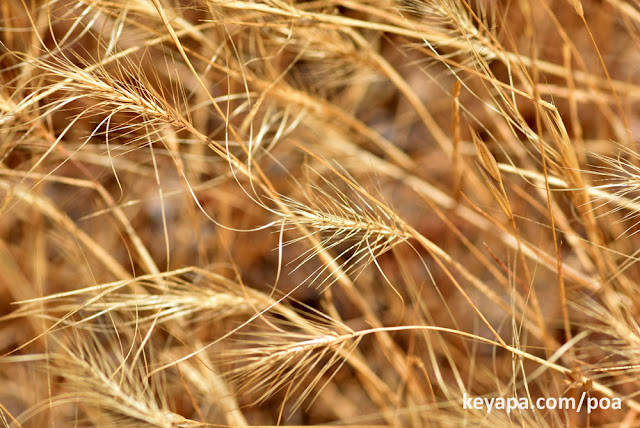I was walking along some side streets during a visit to Reno, NV in July 2019 when I came upon a field of dried golden-colored grass.
I knew that Bromus tectorum (cheatgrass) was present in nearby Lake Tahoe, but a quick examination of the grass showed that it was instead another (and perhaps more serious) invasive species.
 |
| Medusahead grass overruns an abandoned lot in Reno, NV |
Estimates of the current range of T. caput-medusae is that it covers at least 2.2 million hectares in the western USA, and that it is spreading at a rate of 12% every year. Along with other invasive grasses like B. tectorum, it is causing widespread destruction of the iconic sagebrush ecosystem of that region, with the diverse assemblage of species being replaced by vast monocultures.
The spread of T. caput-medusae is mediated by a fascinating feedback process. Studies have shown that it has a difficult time penetrating well-established stands of dominant perennial bunchgrasses, but when some external event results in the temporary clearing of these other grasses, then it can very quickly establish itself and quickly dominate the landscape.
Some of the features of this species that promotes its dominance in any local area include:
1. It is a prolific seed producer and can produce 10,000 seeds per square meter under ideal conditions. Its seeds can then remain viable for several years in the ground.
2. T. caput-medusae forms a very thick thatch layer on the ground. This layer is very high in silica, which prevents quick decomposition and smothers any potential competing plants. T. caput-medusae seedlings however have no problems growing in them.
3. The barbed awns and high silica content deters herbivores, who instead concentrate on competing plants in the vicinity.
4. T. caput-medusae germinates in fall, and continues strengthening its root system over the winter such that by spring it can compete effectively against other plants that are just starting to grow.
Once T. caput-medusae has managed to gain a toehold (or a roothold in this case), there follows a devastating cycle that quickly results in this species dominating the area.
The thick thatch that it produces after its above ground structures senesce accumulates due to its slow biodegradation, and this not only prevents other plants from germinating, but it creates a layer of fine fuels that sooner or later catches fire. The intense fire that develops kills off most of the vegetation without harming the seeds of T. caput-medusae that lie waiting in the soil, and after the fire subsides the vicious cycle begins anew.
The spread of T. caput-medusae is mediated by a fascinating feedback process. Studies have shown that it has a difficult time penetrating well-established stands of dominant perennial bunchgrasses, but when some external event results in the temporary clearing of these other grasses, then it can very quickly establish itself and quickly dominate the landscape.
 |
| Photo credit: Steve Dewey, Utah State University, Bugwood.org |
1. It is a prolific seed producer and can produce 10,000 seeds per square meter under ideal conditions. Its seeds can then remain viable for several years in the ground.
2. T. caput-medusae forms a very thick thatch layer on the ground. This layer is very high in silica, which prevents quick decomposition and smothers any potential competing plants. T. caput-medusae seedlings however have no problems growing in them.
3. The barbed awns and high silica content deters herbivores, who instead concentrate on competing plants in the vicinity.
4. T. caput-medusae germinates in fall, and continues strengthening its root system over the winter such that by spring it can compete effectively against other plants that are just starting to grow.
Once T. caput-medusae has managed to gain a toehold (or a roothold in this case), there follows a devastating cycle that quickly results in this species dominating the area.
The thick thatch that it produces after its above ground structures senesce accumulates due to its slow biodegradation, and this not only prevents other plants from germinating, but it creates a layer of fine fuels that sooner or later catches fire. The intense fire that develops kills off most of the vegetation without harming the seeds of T. caput-medusae that lie waiting in the soil, and after the fire subsides the vicious cycle begins anew.























































